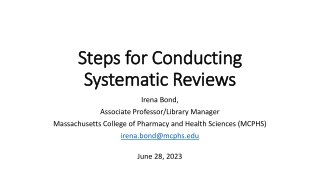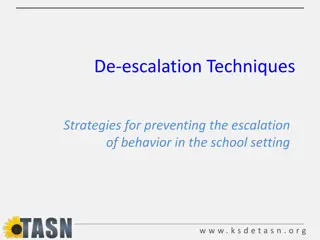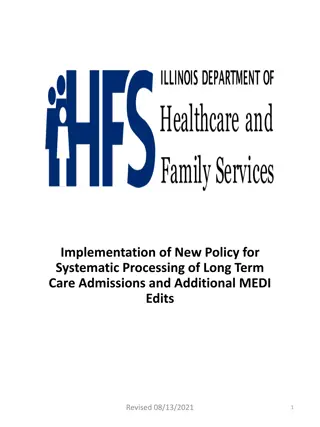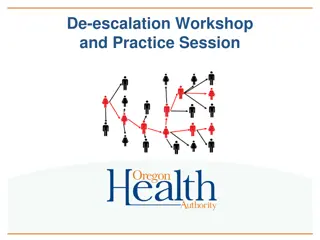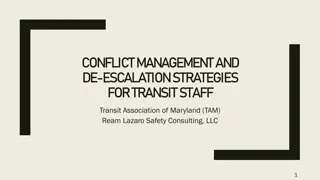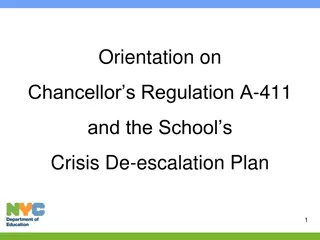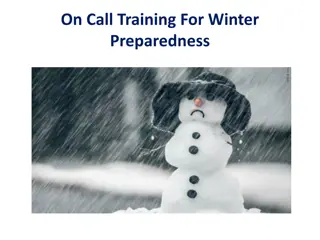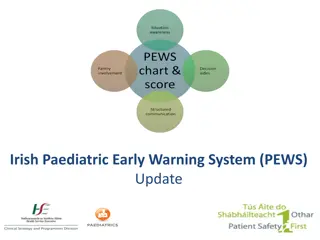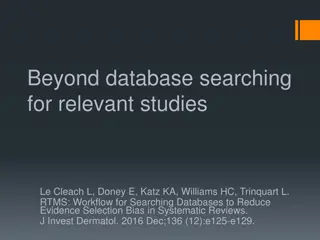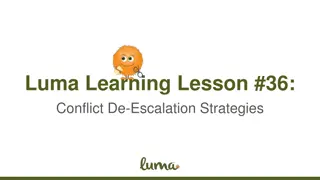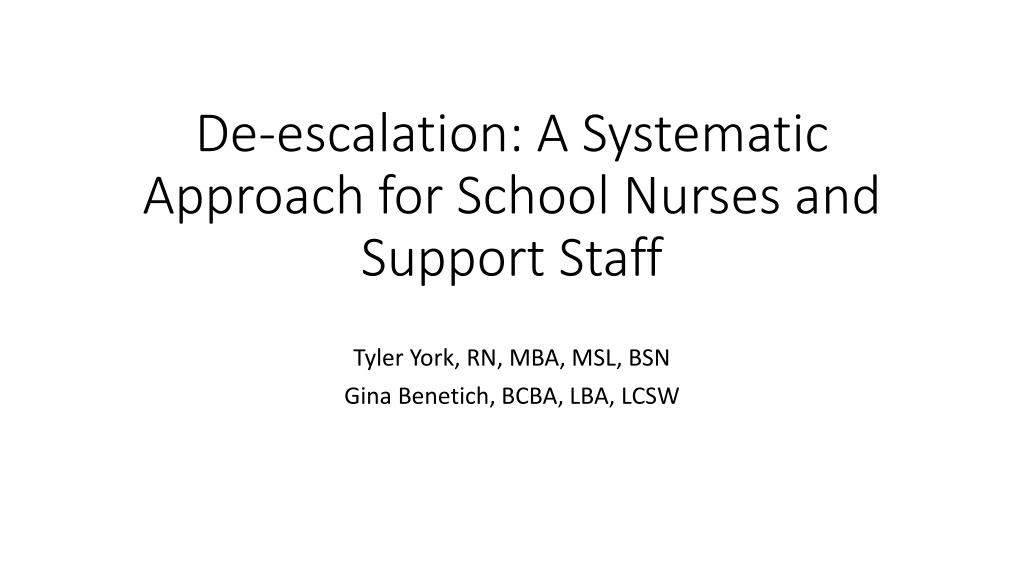
Systematic Approach for De-escalation in Schools
Learn about the systematic approach for de-escalation in schools, focusing on building relationships, non-crisis assessment, crisis management, and positive outcomes to mitigate crises effectively. Explore the challenges faced in prioritizing relationship-building with students and proposed responses to overcome them.
Download Presentation

Please find below an Image/Link to download the presentation.
The content on the website is provided AS IS for your information and personal use only. It may not be sold, licensed, or shared on other websites without obtaining consent from the author. If you encounter any issues during the download, it is possible that the publisher has removed the file from their server.
You are allowed to download the files provided on this website for personal or commercial use, subject to the condition that they are used lawfully. All files are the property of their respective owners.
The content on the website is provided AS IS for your information and personal use only. It may not be sold, licensed, or shared on other websites without obtaining consent from the author.
E N D
Presentation Transcript
De-escalation: A Systematic Approach for School Nurses and Support Staff Tyler York, RN, MBA, MSL, BSN Gina Benetich, BCBA, LBA, LCSW
Data on Incidents in Public schools Public Schools Reporting Discipline Problems (weekly occurrences) 2009-2010 vs 2019-2020 Student verbal abuse of teachers: 5% Increase Widespread disorder in classroom: 1.6% Increase Student acts of disrespect for teachers other than verbal abuse: 6.7% Increase 2019-20 Data Impacted by Coronavirus (Irwin et al., 2021) National Center for Education Statistics (NCES)
Concept Map: Escalation to Resolution Relationship Building Non-crisis Assessment Establish Relationship Team Discussion of Crisis Event Student Specific Huddle Documentation Onset of Initial Crisis Crisis Assessment Preparing to Engage Soft Conversation Post Incident Huddle Initial Approach Critical Stage of Crisis Direct Conversation Skill Team Identification for Response Team Members and Roles Team Response De-escalation
Establish Relationship Establish Relationship The 1st Phase of Concept Map: Establish & Build Relationship Post Incident Huddle Initial Approach Stepping Outside of Nursing Office Nurse & Support Staff Focus: What makes student happy? What makes the student Sad? How do we know when you re sad, upset or angry? What helps when you are sad, upset or angry? Specific to Nurse: Consider Predisposing Factors, Medical history, current medical conditions and Cultural and Social factors. De-escalation Team Response What challenges exist with prioritizing relationship building with students?
Establish Relationship Challenges Proposed Response 1. High Student Population 1. Focused toward students with highest utilization of services (Behavioral) 2. Time Management & Conflicting Objectives 2. Develop workflows with a focus toward student engagement 3. Poor student engagement toward Nurse or Staff 3. Respect boundaries, remain professional, seek to understand Why Should a Nurse Establish a Relationship with Students?
Establish Relationship Purpose: Develop and maintain effective therapeutic relationship Establish clear boundaries Outcomes: Greater chance of crisis mitigation Greater chance of positive response during initial onset of crisis
Initial Approach The 2nd Phase of Concept Map: Onset of Crisis Nursing Assessment Preparing to Engage Soft Conversation Establish Relationship Post Incident Huddle Initial Approach Nurse and Staff Initial Response: Minimum two (2) Staff approach to student in crisis Teacher/Staff request Nurse assistance Provide student with privacy from peers Nurse: Conduct Modified Psychosocial Assessment Engage Soft Conversation Continue to assess for de-escalation OR continued escalation of crisis De-escalation Team Response
Initial Approach - Modified Psychosocial Assessment No words required, Visual Assessment, Presence & Active listening Student Assessment Modified Anxiety Level: Alert, jittery , Hypervigilant, withdrawn, disoriented Mood/Affect: Sad, Suspicious, Apathetic, angry, hostile Thought Process & Communication: (If student is speaking) rapid flow, coherent, tangential, rumination, Logical, blocking Student Environmental Engagement Observe for: Is the student looking around for objects? (pencil, book, etc.) Is the student focused on door or exit? Is the student focused on a specific individual? Is the student posturing? Monitor & Assess for Danger to Others or Self Always Assess for Safety Two (2) Staff Minimum approach
Initial Approach Preparing to Engage Frontal Lobe in control The Escalation Cycle Colvin, 2004
Initial Approach Preparing to Engage Logistical Considerations: Location Positioning Proximity Private area in classroom Ask student Can I sit by you Eye Level Hallway / bench outdoor Relationship, past interactions Eye contact don t force Nurse / counselor office Read student s body language Standing or sitting Walk and talk Social touch Side by side / face to face Current location of student Strategic - ready to block/leave Ability to move quickly
Initial Approach Preparing to Engage Personal Considerations: Self Check Body Language Nonverbal Paraverbal Calm / Rational Posture open -facing, turning, arms Eye contact Comfortable with role Tone Approach - slow, calm, see you Facial expressions attentive, empathy Other staff availability Volume Stance relaxed, stand, sit, squat Gestures gentle movements, haptics Urgency / Simple Solution Speed Use of objects water, soft item Pin in responsibilities
Initial Approach Soft Conversation Components Examples Non-examples Call student by name Use eye contact Focus all your attention Set distractions aside Seek to Understand Use empathy Talking to others Checking your phone Multi-tasking Undivided Attention Criticizing actions Minimizing feelings Correcting or lecturing Interrupting the student Thinking about other things Planning what to say next Nonjudgmental Ask questions Restate Paraphrase Clarify Gather information Discuss emotions Label emotions Identify trigger Discuss possible solutions Support a resolution Active Listening Speeding through the discussion Skipping talking about feelings/emotions Speeding through the talk Skipping discussion on feelings Guiding students to get over it and move on Telling students what to do Feelings and Facts Pinpoint Resolution
Initial Approach Soft Conversation Don t focus on WHAT to say! Considerations: Focus on being: Present Understanding Solution-focused Preventing escalation Needs met physical, environmental Social skills peer issues, model skill Emotional support recognize, manage Break quiet place, deep breaths, head down Calming fidget, favorite item, grounding Thoughts beliefs, reframing self talk
Initial Approach Soft Conversation Buzzword Co-regulation The way that the nervous system of one individual influences the nervous system of another. Polyvagal theory - the reciprocal sending and receiving of signals of safety ANS Using one person s various types of responses, including but not limited to: a warm, calming presence and tone of voice, verbal acknowledgement of distress, modeling of behaviors that can modulate arousal, and the provision of a structured environment that supports emotional and physical safety. Connecting with a child who's in distress and being able to evaluate what that child needs in the moment to help calm themselves. Co-regulation Source Source Source Source Self-regulation
Initial Approach Soft Conversation Admin for Children and Families
Team Response Establish Relationship The 3rd Phase of Concept Map: Team Identification for Response Post Incident Huddle Initial Approach Team members and Roles Team Identification for Student in Crisis: Recommendations for team Brief outline of roles of team members Team Response De-escalation
Team Response Meet prior to crisis to develop school level plan for CRT. CRT Roles Nurse Role: (Can Lead or Support) Continue de-escalation conversation or give report for hand-off Remain present to assess for safety Provide recommendation de-escalation or safety School Administration Role: (Can Lead or Support) Direct observation of student Contacting outside agency (Mobile Crisis Team, Law Enforcement, etc.) Provide recommendation de-escalation or safety Counselor OR Psychologist Role: (Can Lead or Support) Direct observation of student Provide recommendation for de-escalation or safety Crisis Response Team (CRT) School Counselor OR Psychologist Nurse Administration
Establish Relationship De-escalation The 4th Phase of Concept Map: Things to Avoid Post Incident Huddle Initial Approach Verbal Strategies When De-Escalation Doesn t Work De-escalation Team Response
De-escalation Amygdala in control The Escalation Cycle Colvin, 2004
Dont be a CATALYST De-escalation Things to Avoid Considerations: Physical Interaction Outcome Alone with student/Unknown location Lose self control Disagree / persuade Remain too close/Touch student Watch / stare at student Lie, withhold truths, trick Sitting, squatting, kneeling Discuss triggers/problem Dismiss student s abilities Appear threatening Use big / lots of words / fast speech Push your solution Get trapped door, furniture Give in / bribe / deals outside norms Underestimating Monitor Until Swap Out
De-escalation Verbal Strategies Considerations: Distinction Goal Strategies Empathy Praise Time Reflect and Direct Limits/Reasons Key Points: End typical demands and interactions Key Points: Puts things in perspective Examples: This is a great time for you to do some deep breathing. I m going to The sooner you lower your voice, the sooner we can discuss what Discussing Content Examples: Key Points: Conveys you understand them / issue Find things the student is doing well and point it out Direct Appropriate/Acceptable Provides reason or rationale Examples: I know it s real hard when someone tells you no . check on something and be back in a few minutes. happened. Key Points: Key Points: Reflect Inappropriate Behavior Examples: Examples: I appreciate you lowering your voice. Right now you re yelling. Please lower your voice. Vs. Suggest a strategy or reflection Helps student feel heard / cared for Allow student time to think/do Brief/Specific Positively stated Competing or opposite Maintain expectations Thanks for sitting back down. You re pacing around the office. It would be helpful if you sit in this time you ll have for lunch and recess. I get how frustrating it is when things don t work out. Nice job taking some deep breaths. to squeeze your stress ball and I ll be back. The more things you rip up and throw around the bigger the mess you have to clean up. Not Discussing Content Provides immediate feedback to Non-threatening I am going to give you a few minutes The quicker we resolve this, the more Non-judgmental shape behavior in the right direction Silence is OK I m sorry that happened. chair. Genuine Validates efforts made by student Allows staff time (calm, plan) How it benefits student I can understand why you re upset. I notice scissors in your hand. Set them on the desk. Sense of alignment felt by student Why don t you put your head down for a couple minutes while I look for something.
De-escalation - When De-Escalation Doesnt Work Give Report to CRT Standby as Observer Administration Involved Outside Resources
Post Incident Huddle Establish Relationship The 5th Phase of concept Map: The Huddle Staff Student Post Incident Huddle Initial approach De-escalation Team Response
Post Incident Huddle Post Incident Huddle Staff Specific Huddle Student Specific Huddle Debrief all staff involved in the incident Assessment Relationship Building Gather Information for Documentation Successes Areas for Improvement Action Plan Documentation - key stakeholder
Post Incident Huddle Student Huddle Nursing Assessment: Modified Psychosocial assessment Assess for Injuries (I.e. Does anything hurt?, Assess Visible Skin, etc.) Relationship Building & Recovery Active listening & presence Gather Information for Documentation Based on level of crisis and response, State-level documentation may be required.
Concept Map: Escalation to Resolution Relationship Building Non-crisis Assessment Establish Relationship Team Discussion of Crisis Event Student Specific Huddle Documentation Onset of Initial Crisis Crisis Assessment Preparing to Engage Soft Conversation Post Incident Huddle Initial Approach Critical Stage of Crisis Direct Conversation Skill Team Identification for Response Team Members and Roles Team Response De-escalation
Reference 1. Colvin, Geoff. 2004. Managing the cycle of acting-out behavior in the classroom. Eugene, OR: Behavior Associates. 2. Frei, A., and Herman-Stahl, M. (2021). Co-Regulation in Practice Series. OPRE Brief #2021-91, Washington, DC: Office of Planning, Research and Evaluation, Administration for Children and Families, U.S. Department of Health and Human Services. 3. Irwin, V., Wang, ke, Cui, J., & Thompson, A. (2021, May). Report on indicators of School Crime and Safety: 2021. https://nces.ed.gov/pubs2022/2022092.pdf

